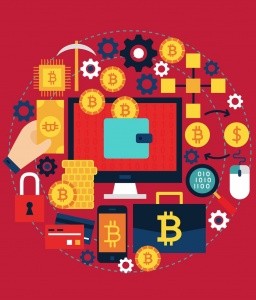Blockchain Technology Templates Start the discussion!

What is a blockchain?
A blockchain is fundamentally a database. It gets its name from the way it stores its data. A traditional database records and stores its information on a ledger or as a list. For example, Visa will record its transactions on a ledger. Blockchain on the other hand stores its data in blocks and each block is like a mini ledger with a list of transactions. It is only when the transactions in a block are validated that the block is added to the blockchain. When a block has been added to the blockchain, it is immutable. This is because every block contains a hash, a unique string of letters and numbers as well as the hash of the block before it. This means if you change the hash of a block or try to swap blocks, it wouldn’t fit with the other blocks in the chain and so would break the chain. The reason this is such a revolutionary data storage technique is it means any attempt to alter the information on a previous block will be unsuccessful. In effect, you have a long chain of these unalterable data blocks which in essence is a timeline of numerous transactions. It is worth mentioning blockchains can record data of any sort so doesn’t necessarily need to be transactions. They can also be used to record legal contracts, track inventory and much more.
What is a blockchain template?
A blockchain template is a model or framework aimed to show you how a company can implement blockchain technology to increase the security and efficiency of the transactions they carry out.
What makes the transactions so secure?
It is more secure than a normal database in two senses. The data is harder to lose and harder to manipulate. The data cannot be lost because differently to a traditional database where all the data will be stored on a server or multiple servers all in the same place, blockchain data is stored on nodes or computers which can be accessed by anyone anywhere. Anyone being able to have access to the blockchain is exactly what makes the information practically impossible for bad actors to manipulate to an unfair advantage. Blockchain uses a system called peer review to do this. The way it works is when a new block (which remember is just a list of transactions) is being added to the blockchain, everyone can see this list of transactions. These lists are cross-referenced by everyone in the community so insofar as everyone has the same list, we can be sure the transactions are legitimate. This is because if one person adds a fake transaction, everyone else’s ledger won’t have this transaction on it and so it will be obvious that it is made up.
Why is this system better?
This system means we do not need to trust a third party to not manipulate the data in anyway. Traditionally a third party would verify transactions and the community of users wouldn’t have access to the data but with blockchain the verification system is decentralised and carried out by the community of computers who all have a copy of the ledger. The transparency of this system makes it more reliable.
Furthermore, because the data isn’t stored in one place, for example on a company data farm where all the servers are under one roof, it means there is no risk of either losing the data, which could happen if that data farm burnt down or robbed, or it becoming unavailable as a result of a power cut or a virus.
Blockchains act as an incredibly useful way to store sensitive information. It requires no trust of a centralised authority and the information is unalterable and thus extremely reliable. Because it is practically impossible to corrupt the data, this makes blockchains very useful when storing sensitive information such as the details of legal contracts or a history of transactions.
Negatives of blockchain
- Difficult to understand
- Can be very expensive for a company to implement – this can delay its mass adoption.
- It is theoretically possible to manipulate a blockchain to an unfair advantage and due to its decentralised nature, if such a circumstance does arise, there is no central authority who can do anything about it. For example, if a fraudulent bitcoin transaction is validated on the blockchain at your expense, there is no Bitcoin customer service helpline you can call to get your money back.
- It is bad for the environment – the whole system requires extremely large amounts of computer power to operate. Compared to a centralised system where the data set only needs to be stored once or twice (if it is backed up), all the data in a blockchain is stored on every node that has access to it. The system relies on peer review so the more people reviewing the transactions, the more secure they are but in turn the more computer power is used and the more significant of a negative impact on the environment.
For more on Blockchain & Blockchain templates
Youtube video demonstrating how Blockchain works through the example of Bitcoin
How Blockchain works in business



